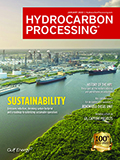
January 2022
Special Focus: Sustainability
The U.S. Energy Information Administration projects that carbon dioxide (CO<sub>2</sub>) emissions will decrease through 2050 in Organization for Economic Co-operation and Development countries (OECD), which includes the U.S.<sup>1</sup>
In a post-pandemic economy, global governments and industry participants are increasingly committing to meeting climate action targets.
From ethanol and renewable diesel to biofuels and gas-to-liquids, the world is moving toward low-carbon energy sources to mitigate climate change and boost energy security.
The need to reduce emissions has never been greater.
Biofuels, Alternative/Renewable Fuels
Designs for the process configuration and operation of the unit are fundamental aspects in the production of renewable diesel.
The marine shipping industry, which accounts for 80% of global trade and 3% of annual global carbon emissions,<sup>1</sup> must adhere to stringent International Maritime Organization (IMO) goals of reducing total annual greenhouse gas (GHG) emissions by at least 50% below 2008 levels by 2050.<sup>2</sup>
Carbon Capture/CO2 Mitigation
In recent years, growing concern about increasing atmospheric carbon dioxide (CO<sub>2<sub/>) levels has put mounting pressure on governments and on processing industries to curb carbon emissions.
100th Anniversary
Over the next 10 mos, <i>Hydrocarbon Processing</i> will provide a detailed history of the origins and evolution of the hydrocarbon processing industry (HPI).
The following is a mixture of technical articles, columns and headlines published in the 1920s by <i>The Refiner and Natural Gasoline Manufacturer</i>, the forerunner to <i>Hydrocarbon Processing</i>.
Carl von Linde was a German scientist and engineer who pioneered new technologies in refrigeration and the invention of air separation and gas liquefaction processes.
Bio-Based Processing
Diesel with a portion of biologically sourced carbon is being produced at an increasing number of conventional crude oil refineries.
Heat Transfer
Fired heaters are facing scrutiny because they contribute to the global emissions of carbon dioxide (CO<sub>2</sub>) and nitrogen oxides (NO<sub>x</sub>).
Transfer-line exchangers (TLEs) are specific shell-and-tube heat exchangers installed out of hydrocarbons steam cracking furnaces for olefins production.
Shell-and-tube heat exchangers use multiple girth flange joints based on their Tubular Exchangers Manufacturers Association (TEMA) type to assemble shell and tube sides.
Columns
It is my esteemed honor to announce that <i>Hydrocarbon Processing</i> is entering its centennial year of publishing.
Good managers manage people who solve problems.
<i>Hydrocarbon Processing (HP)</i> sat down with Stan Knez (SK), Chief Technology Officer, Technip Energies, to get his insights on decarbonization, digital and process technologies and sustainability within the processing industries.
Mechanical systems, especially rotary equipment, are designed to support easy maintenance jobs with less complexity and low chances of incorrect installation.
Trends and Resources
<i>Hydrocarbon Processing,</i> would like to congratulate Catherine Watkins, Vice President Downstream and Publisher, <i>Hydrocarbon Processing</i>, <i>Gas Processing & LNG</i> and <i>H2Tech</i>, for being honored as one of the top women in media for 2021.
Eni plans to launch its 3.4-MMtpy FLNG vessel offshore Mozambique this year. The Coral Sul FLNG vessel is being built by Samsung Heavy Industries.
Endress+Hauser has released its new Cerabar and Deltabar pressure and differential pressure instruments (FIG. 1),

- MOL Group introduces eco-friendly Bag-in-Box packaging for lubricants 12/5
- Honeywell to supply integrated automation systems for flagship UK carbon capture projects 12/4
- Aduro Clean Technologies collaborates with ECOCE to advance plastics recycling in Mexico 12/4
- FincoEnergies launches GoodFuels B15: A reliable and compliant drop-in biofuel for inland shipping 12/4
- DevvStream, Southern Energy Renewables target low-cost, carbon-negative SAF and green methanol 12/4
- AFPM: Revised fuel economy standards would put CAFE back on solid legal footing 12/4




